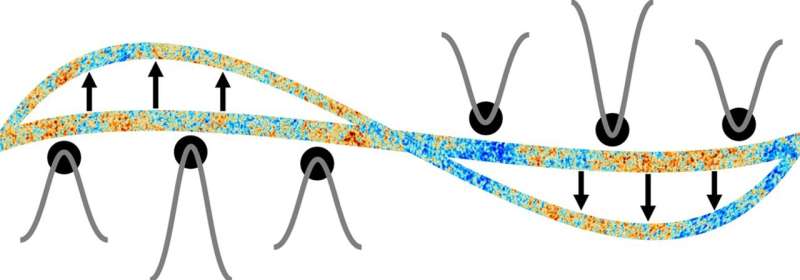This article has been reviewed according to Science X's editorial process and policies. Editors have highlighted the following attributes while ensuring the content's credibility:
fact-checked
peer-reviewed publication
trusted source
proofread
New model aims to explain the lack of miniature black holes in the early universe

Researchers at the Research Center for the Early Universe (RESCEU) and Kavli Institute for the Physics and Mathematics of the Universe (Kavli IPMU, WPI) at the University of Tokyo have applied the well-understood and highly verified quantum field theory, usually applied to the study of the very small, to a new target, the early universe.
Their exploration led to the conclusion that there ought to be far fewer miniature black holes than most models suggest, though observations to confirm this should soon be possible. The specific kind of black hole in question could be a contender for dark matter. Their work has been published in Physical Review Letters and Physical Review D.
The study of the universe can be a daunting thing, so let's make sure we're all on the same page. Though details are fuzzy, the general consensus among physicists is that the universe is about 13.8 billion years old, began with a bang, expanded rapidly in a period called inflation, and somewhere along the line went from being homogenous to containing detail and structure.
Most of the universe is empty, but despite this, it appears to be significantly heavier than can be explained by what we can see—we call this discrepancy dark matter, and no one knows what this might be, but evidence is building that it might be black holes, specifically old ones.
"We call them primordial black holes (PBH), and many researchers feel they are a strong candidate for dark matter, but there would need to be plenty of them to satisfy that theory," said graduate student Jason Kristiano.
"They are interesting for other reasons too, as since the recent innovation of gravitational wave astronomy, there have been discoveries of binary black hole mergers, which can be explained if PBHs exist in large numbers. But despite these strong reasons for their expected abundance, we have not seen any directly, and now we have a model which should explain why this is the case."
Kristiano and his supervisor, Professor Jun'ichi Yokoyama, presently the director of Kavli IPMU and RESCEU, have extensively explored the various models for PBH formation, but found that the leading contenders do not align with actual observations of the cosmic microwave background (CMB), which is sort of like a leftover fingerprint from the Big Bang explosion marking the beginning of the universe. And if something disagrees with solid observations, it either cannot be true or can only paint part of a picture at best.
In this case, the team used a novel approach to correct the leading model of PBH formation from cosmic inflation so it better aligns with current observations and could be further verified with upcoming observations by terrestrial gravitational wave observatories around the world.
"At the beginning, the universe was incredibly small, much smaller than the size of a single atom. Cosmic inflation rapidly expanded that by 25 orders of magnitude. At that time, waves traveling through this tiny space could have had relatively large amplitudes but very short wavelengths. What we have found is that these tiny but strong waves can translate to otherwise inexplicable amplification of much longer waves we see in the present CMB," said Yokoyama.
"We believe this is due to occasional instances of coherence between these early short waves, which can be explained using quantum field theory, the most robust theory we have to describe everyday phenomena such as photons or electrons. While individual short waves would be relatively powerless, coherent groups would have the power to reshape waves much larger than themselves. This is a rare instance of where a theory of something at one extreme scale seems to explain something at the opposite end of the scale."
If, as Kristiano and Yokoyama suggest, early small-scale fluctuations in the universe do affect some of the larger-scale fluctuations we see in the CMB, it might alter the standard explanation of coarse structures in the universe. But also, given we can use measurements of wavelengths in the CMB to effectively constrain the extent of corresponding wavelengths in the early universe, it necessarily constrains any other phenomena that might rely on these shorter, stronger wavelengths. And this is where the PBHs come back in.
"It is widely believed that the collapse of short but strong wavelengths in the early universe is what creates primordial black holes," said Kristiano. "Our study suggests there should be far fewer PBHs than would be needed if they are indeed a strong candidate for dark matter or gravitational wave events."
At the time of writing, the world's gravitational wave observatories, LIGO in the U.S., Virgo in Italy and KAGRA in Japan, are in the midst of an observation mission which aims to observe the first small black holes, likely PBHs. In any case, the results should offer the team solid evidence to help them refine their theory further.
More information: Jason Kristiano, Jun'ichi Yokoyama, Constraining Primordial Black Hole Formation from Single-Field Inflation, Physical Review Letters (2024). journals.aps.org/prl/abstract/ … ysRevLett.132.221003 . On Arxiv: arxiv.org/abs/2211.03395
Jason Kristiano, Jun'ichi Yokoyama, Note on the bispectrum and one-loop corrections in single-field inflation with primordial black hole formation, Physical Review D (2024). journals.aps.org/prd/abstract/ … /PhysRevD.109.103541 . On Arxiv: arxiv.org/abs/2303.00341
Journal information: Physical Review Letters , Physical Review D
Provided by University of Tokyo




















